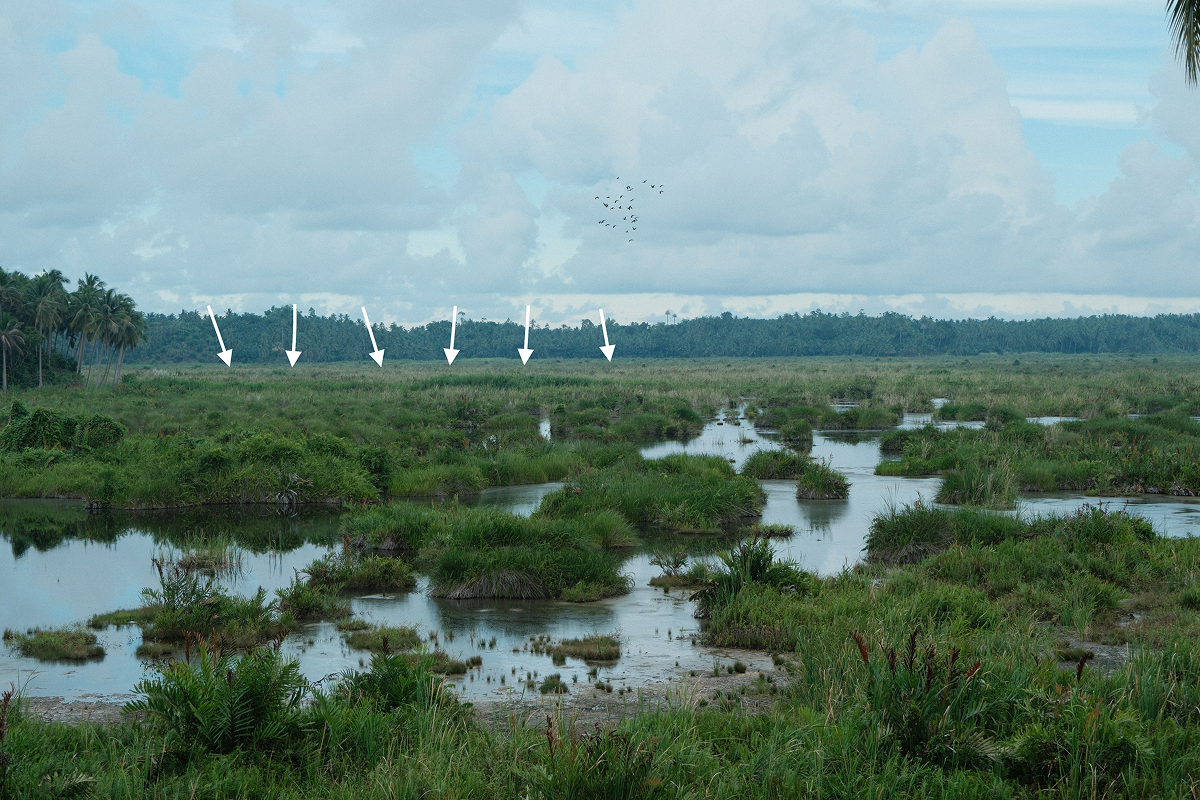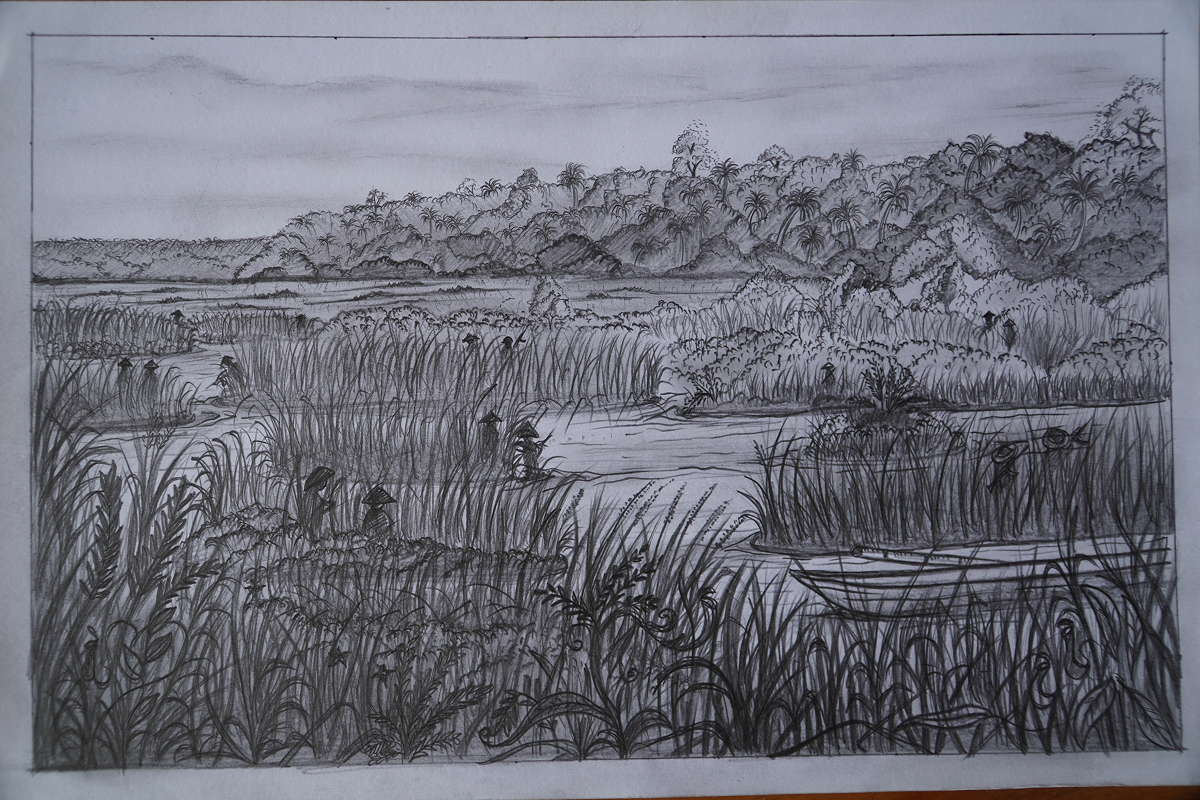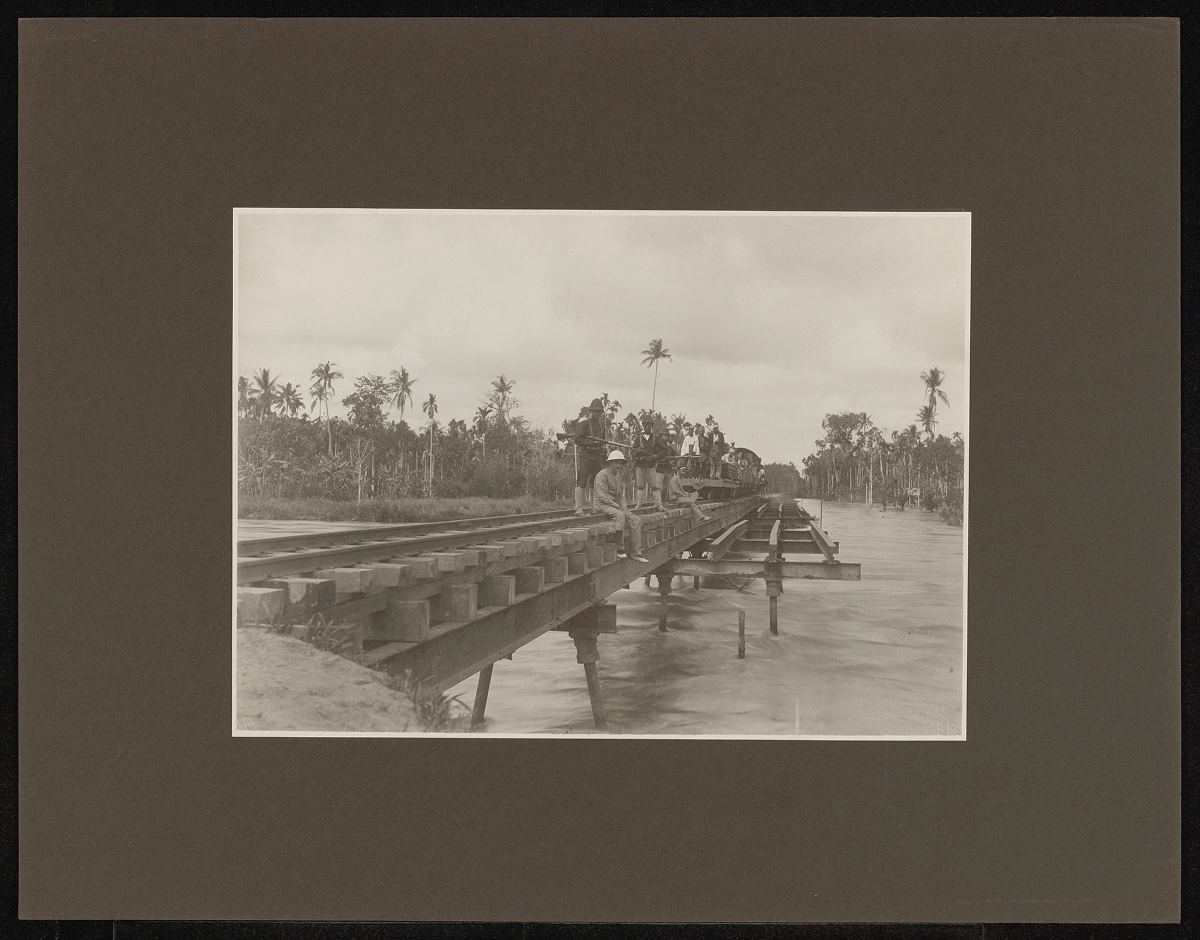Salbiah’s rice field lay lower than most. It was September 2024, and even after a long dry season, water still pooled across its surface. “I couldn’t plant any rice this year,” she observed with frustration. We stood amidst marshland off the Peusangan River on Aceh’s east coast, where the landscape had been partly remade into rice fields under Indonesia’s food estate program, which cast flood-prone areas as “slumbering giants” (raksasa tidur) to be awakened through planting. For such terrain, officials promoted Inbrida Padi Rawa (in short, Inpara) rice, a later generation of Green Revolution varieties bred to grow tall and endure flooding. “But it’s still scared of water when there’s too much,” Salbiah quipped. With no canals or drainage channels, water in her area often rose beyond Inpara’s tolerance range. By contrast, she recalled Si Muà, a deepwater rice once common here, now disappeared. Its name in Acehnese means ‘the brave,’ for the way it fearlessly kept growing taller to match rising floodwaters. This essay traces the disappearance of deepwater rice along the Peusangan through memories of Si Muà, recounted as fields flood without functioning infrastructure. These recollections reveal water management in agriculture as emerging not only from built waterworks but also from the adaptive relations between rice and water, now largely undone by the logics of capitalist development.

With tens of thousands of varieties, Oryza sativa, sometimes called Asian rice, has always been more than food. It has shaped social and ritual life, placemaking processes and projects of collective identity (Bowen 1993; Fox 1997; Ohnuki-Tierney 1993). It has long figured in the power schemes of states (Scott 2009), a dynamic intensified by the US-promoted Green Revolution of the mid-twentieth century, which introduced varieties whose survival depended on state-capitalist technoscience, including hard infrastructure (Shiva 2016). Extending critiques of technoscientific projects, a strand of scholarship rethinks infrastructures built for and by humans as also emerging from the entangled relations of plants, animals, spirits, soil, and other elements (Jensen and Morita 2016). Deepwater rice, a subgroup of O. sativa that inherited stem-elongating traits from wild perennial grasses, is especially good to think with in this regard (Catling 1992). In Thailand’s Chao Phraya catchment, for instance, Atsuro Morita (2017) demonstrates how small patches of cultivated deepwater rice help mitigate flood risks to Bangkok, revealing flood control as a “multispecies infrastructure” in which rice plays an active part.
In the riverine floodplains of Aceh’s east coast, farmers once cultivated several varieties of deepwater rice (padé paja), of which Si Muà was one. Rather than in embanked fields (sawah), this rice was cultivated in open patches where weeds mingled with the crop, making it easy to mistake the patches for nothing more than marsh. Much like elites’ condemnation of swidden agriculture in the uplands as irrational and uncontrollable (Dove 1985), this mode of cultivation in the lowlands was portrayed in the eighteenth-century Acehnese epic Hikayat Pocut Muhammad as slack and disorderly farming (Siegel 1979). Two centuries later, the Bimas (Bimbingan Massal, or mass guidance) program sought to reform these “traditional” practices by promoting state-approved rice varieties (McVey 1990). Farmers in Aceh, however, note that state-backed rice, bundled as it is with fertilizers, pesticides and credit, arrives before the requisite canals or channels – gaps in timing that have turned the promise of modernity into “infrastructural violence” (Rodgers and O’Neill 2012). Yet from within these very gaps, memories of deepwater rice that survived without infrastructural support resurface. Like memories of lost foods under modernity more broadly, they can form the basis for political critique while making different configurations of infrastructure visible (Seremetakis 1994; Carse and Kneas 2019).
One morning in September, I went with a group of women from a village bordering the Peusangan into one of the marshes, barefoot but for knee-high football socks, a modest armor against freshwater leeches. They were gathering binyeut, a sedge used for weaving, to meet a commissioned order of handwoven bags as corporate merchandise from Pupuk Iskandar Muda, a state-owned fertilizer company. As we searched for a good patch, my foot struck a firm strip of earth, just high enough to catch a step or snag a canoe. The women explained that it was the remnant of a village-funded embankment, later submerged when the Peusangan breached in 2017. I knew of this flood from stories of an important bridge that had washed away on the road between Aceh and North Sumatra, though I had not realized the water reached this far. They reminded me the waters here had in fact risen from below, part of a marshland-river continuum, a “fluid space” of surface flows and underground capillaries (Steinberg and Peters 2015). This diffuse hydrological space, never fully containable, is what built agricultural waterworks and Inpara must constantly contend with.

From these flooded fields, some farmers wait or lobby for waterworks, others sell. Still others speak of the history of deepwater rice cultivation in this landscape. They reference Si Muà, but also Manyang Meuhamboe and Manyang Röe, each remembered for its distinctive sensory qualities, but, most notably, its shared ability to elongate with rising water. “I’d ride in a canoe with my grandmother to check on the rice was after the high waters. We didn’t have irrigation back then either,” Salbiah recalled. “The rice would be there, only taller. The other grasses drifted away.” Evoked in a flood-prone landscape without built waterworks, Salbiah’s memory gestures toward a relational understanding of water management grounded in the interplay between rice and water, where management arises not through external waterworks but through the plant’s capacity to keep elongating and adjusting with hydrological rhythms. In this sense, elongation shares with built waterworks the infrastructural capacity to work with and manage water, yet does so through adaptive living rather than through inert architectures of control.
How did deepwater rice disappear from the Peusangan floodplain? Alongside state-backed Green Revolution reforms, farmers often point to the civil war between the Free Aceh Movement (Gerakan Aceh Merdeka) and the Indonesian state from 1975 to 2005, when the marshlands became both refuge and battleground, later depicted in Acehnese writer Ida Fitri’s novel Paya Nie (2024). In those years, farmers generally stayed away from the marshes. Yet the rice’s disappearance also followed prevailing ideas of what made some kinds of rice more valuable than others—commercially, ritually, and socially. Farmers recalled Si Muà’s thin, narrow grains, which when cooked were firm, less sticky than popular varieties, and had a coarse, nutty mouthfeel with an aromatic scent when cooked. It was everyday rice, eaten at home, but had little market demand and was never served at kandoeri feasts for weddings, births, funerals, or other ceremonies, where rice from sawah was preferred for being sweeter, softer, fuller, and more presentable (pantas). As one farmer put it, everything that came from the marsh back then, even the fish, like snakeheads (bacee), was considered lowly.


At the same time, the disappearance of deepwater rice needs to be understood through broader and longer transformations of the Peusangan’s riverscape and hydrology. Industrial water intake facilities have lined its banks since the 1980s, their pipelines leading to factories, ports, offices, and housing in nearby Lhokseumawe, known in the late twentieth century as Petrodollar City, a name earned during the gas boom. In doing so, the riverbanks have been hardened in various sections, from metal piling to concrete lining, continuing a history of efforts to “normalize” the Peusangan’s flow. In the early twentieth century, for instance, Dutch engineers canalized this stretch to its outlet at the Malacca Straits in an effort to protect the railway lines and roads running along Aceh’s east coast from encroaching water during the colonial occupation. These interventions exemplify what Anna Tsing et al. (2019) call “modular simplifications,” the streamlining of ecological complexity in the name of control. They transformed the Peusangan from a slow, braided river—its main channel, as one farmer put it, “only as wide as a betel nut tree split in half”—into a fast, linear channel, bringing fewer but more destructive floods and disrupting the hydrology for deepwater rice patches.

With deepwater rice gone, farmers in Aceh have grown dependent on hard-engineered agricultural works, long accessible mainly to wealthier or more resourceful rural residents since Indonesia’s early Green Revolution (Stoler 1977; Winarto 2004). Inpara, though bred to be tall, cannot match Si Muà’s elongating capacity without sacrificing yield, as taller plants divert more energy to stems than to grain. This trade-off sits uneasily with the state’s push for capitalist rice production, even in regions like Aceh, where only some areas were historically commercial rice-growing zones (Andaya 2008). Yet for farmers like Salbiah, deepwater rice was never about producing abundance but about the assurance that there would always be rice at home, come high water or not. “These days, if you don’t have rice from the fields, there’s Raskin,” she chuckled[1]. “These days, if you don’t have rice from the fields, there’s Raskin,” she chuckled. Alongside such wry reflections on what rice farming has become, the memory of Si Muà endures, holding open other relations with water foreclosed by dominant assumptions and norms about agricultural waterworks.
Andaya, Leonard. 2008. Leaves of the Same Tree: Trade and Ethnicity in the Straits of Melaka. Honolulu, HI: University of Hawai’i Press.
Bowen, John R. 1993. Muslims through Discourse: Religion and Ritual in Gayo Society. Princeton, NJ: Princeton University Press.
Carse, Ashley and David Kneas. 2019. “Unbuilt and Unfinished: The Temporalities of Infrastructure.” Environment and Society 10 (1): 9–28.
Catling, David. 1992. Rice in Deep Water. London: The Macmillan Press Ltd.
Dove, Michael R. 1985. “The Agroecological Mythology of the Javanese and the Political Economy of Indonesia.” Indonesia 39: 1–36.
Fitri, Ida. 2024. Paya Nie. Jakarta: Marjin Kiri.
Fox, James J. 1997. “Genealogy and Topogeny: Toward an Ethnography of Rotinese Ritual Place Names.” In The Poetic Power of Place: Comparative Perspectives on Austronesian Ideas of Locality, edited by James J. Fox, 89–100. Canberra: Australian National University Press.
Jensen, Casper Bruun and Atsuro Morita. 2017. “Introduction: Infrastructures as Ontological Experiments.” Ethnos 82 (4): 615–26.
McVey, Ruth T. 1990. “Teaching Modernity: The PKI as an Educational Institution.” Indonesia 50 (2): 5–28.
Morita, Atsuro. 2017. “Multispecies Infrastructure: Flood Control, Deepwater Rice, and Human–Nature Entanglements in the Chao Phraya Delta, Thailand.” Ethnos 82 (4): 738–57.
Ohnuki-Tierney, Emiko. 1993. Rice as Self: Japanese Identities through Time. Princeton, NJ: Princeton University Press.
Rodgers, Dennis and Bruce O’Neill. 2012. “Infrastructural Violence: Introduction to the Special Issue.” Ethnography 13 (4): 401–12. https://www.jstor.org/stable/43497506
Scott, James C. 2009. The Art of Not Being Governed: An Anarchist History of Upland Southeast Asia. New Haven, CT: Yale University Press.
Seremetakis, C. Nadia. 1994. The Senses Still: Perception and Memory as Material Culture in Modernity. Boulder, CO: Westview Press.
Shiva, Vandana. 2016. The Violence of the Green Revolution: Third World Agriculture, Ecology, and Politics. Lexington, KY: University Press of Kentucky.
Siegel, James T. 1979. Shadow and Sound: The Historical Thought of a Sumatran People. Chicago, IL: University of Chicago Press.
Steinberg, Philip and Kimberley Peters. 2015. “Wet Ontologies, Fluid Spaces: Giving Depth to Volume through Oceanic Thinking.” Environment and Planning D: Society and Space 33 (2): 247–64.
Stoler, Ann Laura. 1977. “Rice Harvesting in Kali Loro: A Study of Class and Labor Relations in Rural Java.” American Ethnologist 4 (4): 678–98.
Tsing, Anna Lowenhaupt, Andrew S. Mathews and Nils Bubandt. 2019. “Patchy Anthropocene: Landscape Structure, Multispecies History, and the Retooling of Anthropology: An Introduction to Supplement 20.” Current Anthropology 60 (S20): S186–97. https://doi.org/10.1086/703391
Winarto, Yunita T. 2004. Seeds of Knowledge: The Beginning of Integrated Pest Management in Java. New Haven, CT: Yale University Southeast Asia Studies.
Picture the countryside many Indonesians grow up drawing: two mountains on the horizon, the sun between them, and a road cutting through neat grids of rice fields. The rice field suggests order, whereas the rice patch marks disorder. On a blank page, draw both rice fields and marsh patches. You might find one easier to draw than the other. What might that difference tell us about how we picture control, water and growth?